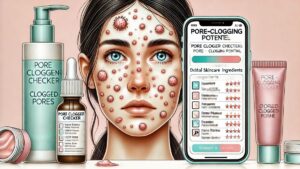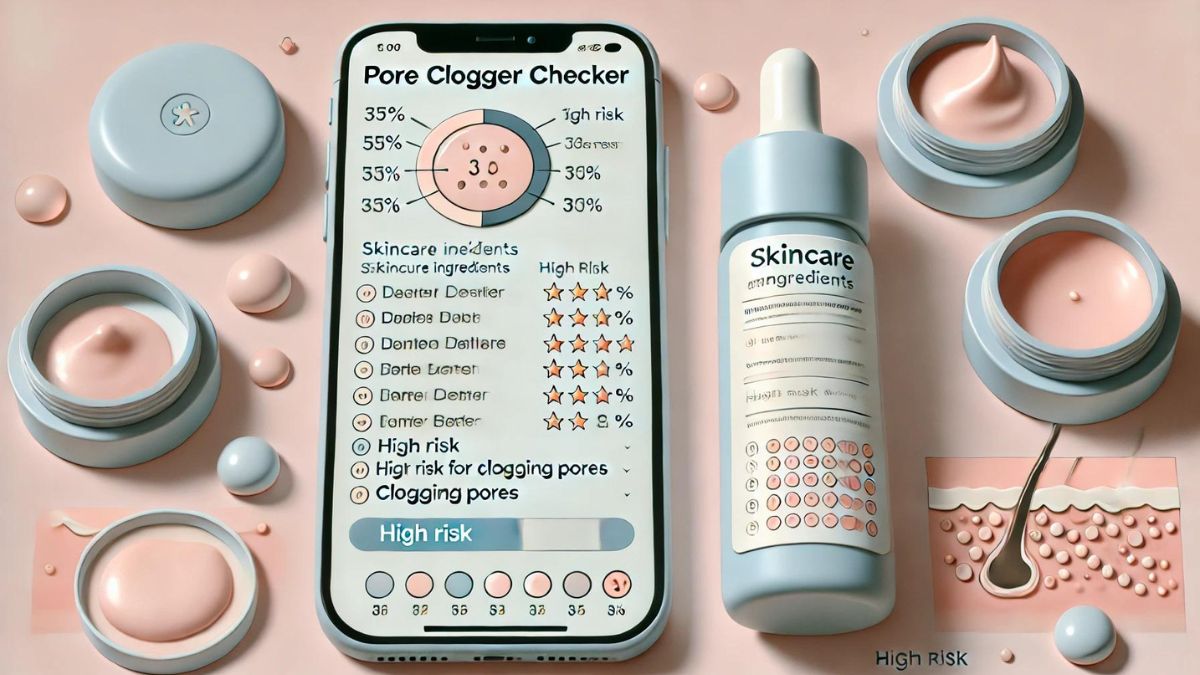In the quest for flawless skin, clogged pores are a common concern. They can lead to acne, blackheads, and dull skin. One of the best ways to prevent this is by using a pore clogger checker. This tool helps identify ingredients in skincare products that could clog pores, known as comedogenic ingredients. Understanding how to check for pore-clogging ingredients can save your skin from unwanted breakouts and irritation.
In this comprehensive guide, we’ll explore the importance of a pore clogger checker, how it works, and what you need to know to keep your skin clear and healthy.

What Is a Pore Clogger Checker?
A pore clogger checker is a tool or method used to assess skincare and makeup ingredients for their potential to clog pores. Pore-clogging ingredients can trigger acne, blackheads, and other forms of skin irritation. By identifying these ingredients, a pore clogger checker helps consumers avoid products that may cause skin issues.
Many websites and apps now provide online pore clogger checkers. These platforms allow users to input the ingredients of their skincare products and receive a rating based on the comedogenic potential of each ingredient.
The Science Behind Pore Clogging
Clogged pores are often the result of excess oil, dirt, and dead skin cells that accumulate and get trapped in hair follicles. This can create a plug, leading to blackheads, whiteheads, or acne. Comedogenic ingredients exacerbate this issue by further obstructing the pores, especially for individuals with oily or combination skin.
Some common pore-clogging ingredients include:
- Coconut oil
- Isopropyl myristate
- Lanolin
- Stearic acid
Why You Need a Pore Clogger Checker
A pore clogger checker is essential because many seemingly harmless ingredients can clog pores, causing breakouts. The checker provides transparency about what you’re applying to your skin, especially when labels can be confusing or incomplete.
For example, even some “non-comedogenic” products can contain ingredients that, in specific concentrations or combinations, might clog pores. Checking these ingredients ensures you avoid those that pose a risk to your skin type.
Expert Opinion
Dermatologists emphasize the importance of understanding what ingredients you are putting on your skin. According to Dr. Joshua Zeichner, a board-certified dermatologist, “Even though a product might be labeled as non-comedogenic, it’s crucial to check the ingredients and how they interact with your skin type. Using a pore clogger checker can help pinpoint specific triggers for acne or irritation.”
How to Use a Pore Clogger Checker
Using a pore clogger checker is straightforward. Follow these steps to ensure you’re making the right choices for your skincare:
1. Gather Your Product Ingredients
Find the ingredient list on the product packaging or online. Most skincare and cosmetic brands are required to list all the ingredients used in their formulas.
2. Input the Ingredients
Visit an online pore clogger checker or download an app. Enter the list of ingredients, either by typing them manually or uploading the list, if supported.
3. Analyze the Results
The checker will assess each ingredient’s comedogenic rating. Typically, the scale ranges from 0 to 5:
- 0: Non-comedogenic
- 1-2: Low potential
- 3: Moderate potential
- 4-5: High potential
If a product contains ingredients rated 3 or above, it’s likely to clog pores, especially for sensitive or acne-prone skin.
4. Make Informed Decisions
Once you have the results, decide if the product is suitable for your skin. Consider avoiding items with high comedogenic ingredients, particularly if you have oily or acne-prone skin.
Examples of Common Comedogenic Ingredients
While some ingredients are beneficial in low concentrations, they may still be rated highly for their comedogenic potential. Here’s a breakdown of a few common offenders:
1. Coconut Oil
Coconut oil is widely praised for its moisturizing properties. However, it ranks high on the comedogenic scale (rating 4), meaning it can block pores for most skin types, especially oily skin.
2. Isopropyl Myristate
This synthetic oil is often used to help products feel smooth and light on the skin. Unfortunately, it has a comedogenic rating of 5, making it one of the worst offenders for clogging pores.
3. Lanolin
Lanolin, derived from sheep’s wool, is used in moisturizing creams but can clog pores, especially in individuals with sensitive skin.
4. Stearic Acid
Stearic acid, a fatty acid found in many cleansers, can be comedogenic depending on the concentration used in a product.
Case Study: A Real-Life Example
A study published by the Journal of the American Academy of Dermatology examined the comedogenicity of ingredients in commonly used skincare products. They found that over 40% of products labeled “non-comedogenic” contained at least one pore-clogging ingredient. This demonstrates the need for using a pore clogger checker before buying new products.
Tips for Choosing Non-Comedogenic Products
Even with a pore clogger checker, choosing the right skincare requires some trial and error. Here are some tips to help you select non-comedogenic products:
- Know your skin type: Oily, combination, and acne-prone skin are more likely to react to comedogenic ingredients.
- Test new products: Patch testing can help you identify potential reactions before applying a product to your face.
- Look for non-comedogenic labels: While these labels aren’t foolproof, they can still guide you toward less risky options.
- Use lightweight products: Lighter formulations, like serums or gels, tend to clog pores less than heavier creams.
Statistics to Consider
According to a survey by the American Academy of Dermatology, 54% of individuals with acne report that using pore-clogging products worsened their condition. However, 83% noticed significant improvements in their skin after switching to non-comedogenic products.
FAQs
1. How do I know if a product will clog my pores?
Using a pore clogger checker is the best way to identify pore-clogging ingredients in your products.
2. Can I still use a product with a few pore-clogging ingredients?
It depends on your skin type. People with dry skin may tolerate such ingredients better than those with oily or acne-prone skin.
3. Are all oils comedogenic?
No, not all oils clog pores. Non-comedogenic oils like jojoba or argan oil are often safe for most skin types.
4. Do I need to use a pore clogger checker for every product?
Yes, if you’re acne-prone or sensitive, it’s a good idea to check every product to avoid potential breakouts.
Conclusion
Using a pore clogger checker can dramatically improve your skincare routine. By identifying and avoiding comedogenic ingredients, you can reduce the likelihood of clogged pores, breakouts, and irritation. Whether you have sensitive, oily, or combination skin, being proactive about what you apply to your face is the key to achieving clear and healthy skin.
Remember, even products labeled as non-comedogenic can contain hidden pore-clogging ingredients. By regularly checking your skincare products, you can ensure they are safe and effective for your skin type.





